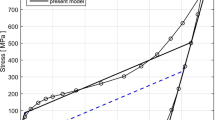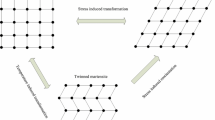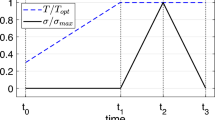Abstract
It is of practical interest to establish a precise constitutive model which includes the equations describing the phase transformation behaviors and thermo-mechanical processes of shape memory alloy (SMA). The microscopic mechanism of super elasticity and shape memory effect of SMA is explained based on the concept of shape memory factor defined by the author of this paper. The conventional super elasticity and shape memory effect of SMA are further unified as shape memory effect. Shape memory factor is redefined in order to make clear its physical meaning. A new shape memory evolution equation is developed to predict the phase transformation behaviors of SMA based on the differential relationship between martensitic volume fraction and phase transformation free energy and the results of DSC test. It overcomes the limitations that the previous shape memory evolution equations or phase transformation equations fail to express the influences of the phase transformation peak temperatures on the phase transformation behaviors and the transformation from twinned martensite to detwinned martensite occurring in SMA. A new macro-mechanical constitutive equation is established to predict the thermo-mechanical processes realizing the shape memory effect of SMA from the expression of Gibbs free energy. It is expanded from one-dimension to three-dimension with assuming SMA as isotropic material. All material constants in the new constitutive equation can be determined from macroscopic experiments, which makes it more easily used in practical applications.
Similar content being viewed by others
References
Yang D Z. Intelligent Materials and Systems (in Chinese). Tianjin: Tianjing University Press, 2000. 104–142
Tanaka K. A thermomechanical sketch of shape memory effects: One-dimension tensile behavior. Res Mech, 1986, 18: 251–263
Liang C, Rogers C A. One-dimensional thermomechanical constitutive relations for shape memory materials. J Intell Mater Syst Struct, 1990, 1: 207–234
Boyd J G, Lagoudas D C. Thermomechanical response of shape memory composites. J Intell Mater Syst Struct, 1994, 5: 333–346
Sun Q P, Hwang K C. Micromechanics modeling for the constitutive behaviors of polycrystalline shape memory alloys. J Mech Phys Solids, 1993, 41: 1–33
Brinson L C. One-dimension constitutive behavior of shape memory alloys: Thermomechanical derivation with non-constant material functions and martensite internal variable. J Intell Mater Syst Struct, 1993, 4: 229–242
Peng X, Yang Y, Huang S. A comprehensive description for shape memory alloys with a two-phase constitutive model. Int J Solids Struct, 2001, 38: 6925–6940
Zhu Y G, Lv H X, Yang D Z. Constitutive model of shape memory alloys (in Chinese). Chin J Mater Res, 2001, 15(6): 263–268
Brocca M, Brinson L C, Bazant Z P. Three-dimension constitutive model for shape memory alloys based on microplane model. J Mech Phys Solids, 2002, 50: 1051–1077
Li H, Peng X, Huang S. A conventional plasticity based two-phase constitutive model for shape memory alloys (in Chinese). Acta Mech Solida Sin, 2004, 25(1): 58–62
Guo Y, Liu F, Dai X, et al. Dynamic pseudoelastic behavior of TiNi alloys and a strain rate dependent phase transition constitutive model (in Chinese). Explos Shock Waves, 2003, 23(2): 105–110
Zhou B, Wang Z, Liang W. A micromechanical constitutive model of shape memory alloys (in Chinese). Acta Metall Sin, 2006, 42(9): 919–924
Zhou B, Yoon S H. A new phase transformation constitutive model of shape memory alloys. Smart Mater Struct, 2006, 15: 1967–1973
Zhou B, Yoon S H. Study on phase transformation and thermomechanical behaviors of Ni-Ti shape memory alloy. In: Batra R C, Qian L F, Zhang Y L, et al., eds. Proceeding of International Conference on Mechanical Engineering and Mechanics. Beijing: Science Press, 2005. 1001–1005
Zhou B, Wan Z Q, Yoon S H, et al. Mechanical behaviors of torsion actuator of shape memory alloy. Key Eng Mater, 2008, 385–387: 213–216
Xiong K, Shen W. Experimental research on the relationship between SMA wire wound angle and SMA torsion actuator primary performances (in Chinese). Chin J Mech Eng, 2003, 39(12): 123–128
Author information
Authors and Affiliations
Corresponding authors
Additional information
Supported by the National Natural Science Foundation of China (Grant No. 95505010), the National High Technology Research and Development Program of China (Grant No. 2006AA03Z109), the China Postdoctoral Science Foundation (Grant No. 20080430933), the Open Foundation of Institute of Engineering Mechanics of National Seism Bureau of China (Grant No. 2007B02), and the Harbin Talent Foundation of Scientific and Technical Innovation (Grant No. RC2009QN-017046)
Rights and permissions
About this article
Cite this article
Zhou, B., Liu, Y., Leng, J. et al. A macro-mechanical constitutive model of shape memory alloys. Sci. China Ser. G-Phys. Mech. Astron. 52, 1382–1391 (2009). https://doi.org/10.1007/s11433-009-0173-3
Received:
Accepted:
Published:
Issue Date:
DOI: https://doi.org/10.1007/s11433-009-0173-3




